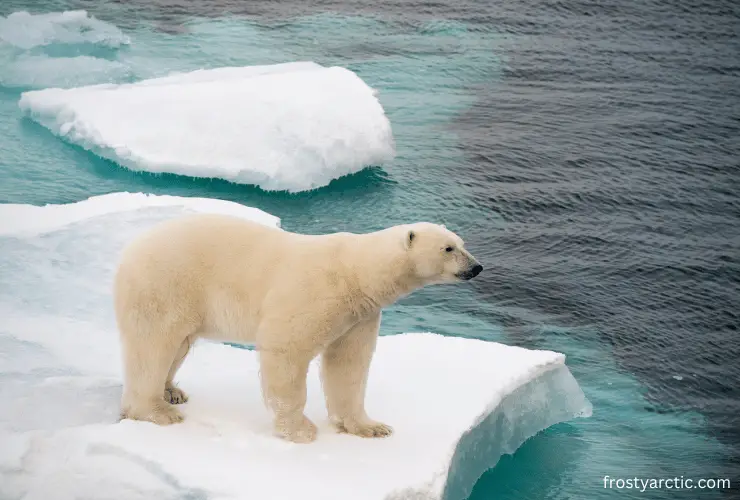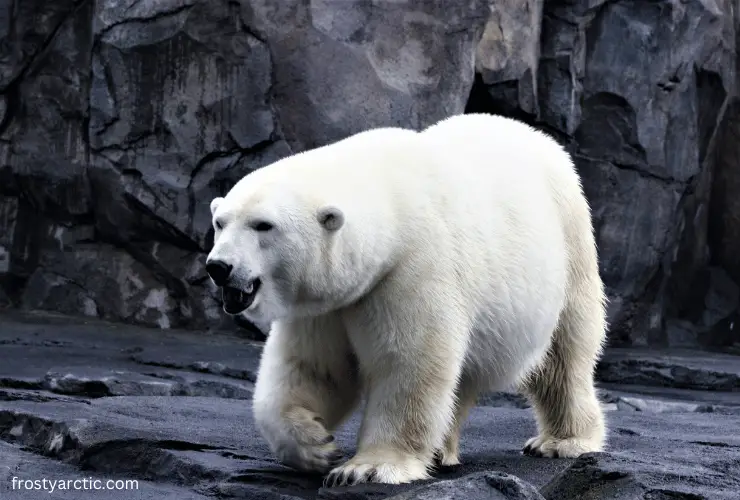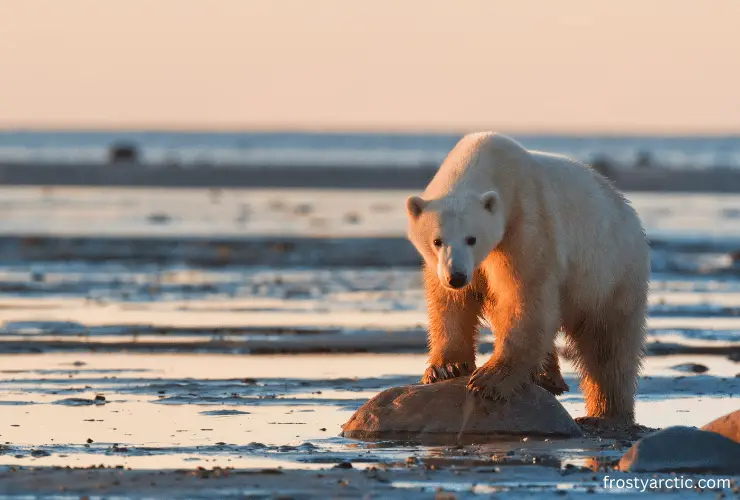Polar bears are colorless or translucent. According to studies, their fur appears white, but their true skin color is black. The fur of some polar bears is also yellow, gray, black, green, orange, radish, and light red. Their skin has two layers of hollow and translucent fur. This means the fur of a polar bear that appears white in our eyes has no true white color.
Have you ever wondered if there are polar bears that appear gray? Do you know what color their nose and paws are? We know your curiosity is touching the seventh heaven. So, we have good news for you: this article’s footprints are totally based on everything related to the color of polar bears.
Just read about the topic and let the canvas decide what color polar bears are. We hope that we will satisfy you by finding your answers about the topic. Let’s begin!
What Is the Real Color of a Polar Bear?
The real color of a polar bear is a combination of transparent hairs and their underlying black skin. However, their fur appears white. That’s why when we see polar bears in pictures, we assume their color is white, which is false. Let’s discuss it in detail to understand it better.

Polar bears have two layers of fur. These layers include:
- The undercoat’s hairs
- The guard hairs
These layers are useful for them. They get extra insulation benefits from these layers. Additionally, both layers do not have any color. These are totally transparent. However, polar bears have black skin underneath these layers of fur. Despite this, polar bears still appear white. Why?
According to the report of the WWF organization, polar bear fur is transparent or translucent. It means their fur does not have any color. Moreover, the fur is hollow, which helps them stay warm in cold temperatures. The hairs of polar bears reflect sunlight. This white reflected light makes them look like white-colored bears.
However, some early theories say it’s not the reason why they are white with hollow hairs. The new studies are still in progress, and up until this point, there has yet to be a clear-cut justification.
What Color Is a Polar Bear When Born?
Pink! Polar bear cubs are pink-colored. Their skin color is pink. But after the passage of time (4 to 5 months later), their skin color turns a little black and then completely black.
Polar bear cubs have brown fur when they are only a few months old. However, their fur turns completely white when they become mature. The cub’s coats turn totally white at the age of 2 or 3.
Are Polar Bears White, Gray, Or Black?

We have discussed before the white color of polar bears as a result of the reflected white color. Similarly, you have probably seen photographs of polar bears that are gray in color. It is because they scatter other colors and absorb gray.
Polar bears reflect gray color when there is no sunlight, and the sky is cloudy. Their fur reflects gray color instead of white due to gray or half-blackish clouds. When they are swimming and wet, they also look gray.
Are they black, too? Yes, the fur of polar bears can also reflect black color. Less commonly, polar bears look black under certain circumstances. This physical adaptation shows how different these creatures are.
What Are the Other Colors of Polar Bears?
Polar bears are not just white, gray, or black. They are also green, yellow, orange, or radish. Let’s delve deeper into the gory details:
1. Green Color
You might have seen polar bears that have green fur or green-shady fur. Green-shaded polar bears are mostly seen in zoos. Their color also changes to green when they are outside the natural habitat of the Arctic.
Professor Steven Amstrup reports the following facts about green polar bears to the Polar Bears International organization:
Algae is the reason behind the green color of polar bears living in zoos. Green algae grow in tiny fur holes. The main cause behind this fact is abrasive pen floors. Also, algae are not grown or even grown in Arctic low temperatures. But in zoos, algae is fully-grown and polar bears love to play and sleep in bedded algae.
2. Yellow Color
Don’t freak! Some polar bears in the Arctic do indeed have yellow or light yellowish fur. According to some studies, scientists give credit to their diet. They report that some polar bears are yellow because of their diet.
The main diet of polar bears is that of ringed and bearded seals. These seals are full of fats and oils, especially in their blubber. Now, these fatty oils are ingested into the bodies of polar bears in large quantities.
Eventually, these oils lead to the yellow coloration of polar bears’ fur. Most bears change their white color to yellow every year, especially in May or June. This time, they shed most of their fur. After some days, their fur comes back or grows again.
3. Orange or Orange-Reddish Color
Mostly, polar bears’ fur is not orange. They are only orange or have an orange-reddish-like tint on their fur at sunset or sunrise. Instead of being a consistent aspect of their fur color, their orange or reddish appearance is a result of the lighting.
What Color Are Polar Bear Eyes and Noses?

According to research, polar bears have dark brown or black colored eyes. Moreover, their eyes are facing forward. We, as humans, use sunglasses or goggles to protect our eyes from harmful rays, dust, or UV rays from sunlight.
Polar bears do not need goggles, though. Their eyes are fully protected from the reflected light of snow. They can filter harmful and damaging UV rays thanks to their built-in membranes. That’s pretty cool!
Now comes the second question: what color are polar bears’ noses? Polar bears have black skin. Similarly, the color of the noses of polar bears is also black. Also, the lips of polar bears are black.
What Color Is a Polar Bear’s Tongue?
Polar bears have black-colored tongues. But there are some instances when their tongue is blue. However, it’s not a crazy fact that polar bears have black tongues. Most of the animals living on Earth also have black tongues. Some of the animals that have black tongues include Shar-Pei dogs, Jersey cattle, chow-chow dogs, giraffes, and blue-tongued skinks.
According to a study, the black color of the polar bear’s tongue is a result of the high concentration of melanin. It is a pigment that provides coloration to the skin and other tissues.
The dark tongue is not a visible feature most of the time. But you may catch a glimpse of it when a polar bear opens its mouth. Another study says they have black tongues because they can reflect UV light.
What Color Is Polar Bears’ Skin? (Without Fur)
Black! Polar Bears have black skin. Their skin does not have white pigments. This can be proved with an experiment. If you see them with the help of an infrared camera, their skin color will be black. Black skin is a distinctive trait of polar bears.
The black skin color of polar bears sets them apart from other bear species. For example, grizzly bears have pink skin. The black skin of polar bears frequently becomes visible through scars around their muzzles. They get scars from confrontations and fights.
But you know what? Scientists are still unaware of why polar bears have black skin. Initially, researchers believed that the black skin of polar bears played a vital role in the thermal radiation effect. It helps them absorb heat from the sun’s UV light.
But let us think for a moment, the Arctic has no sun, or the sun is often seen for a short time. That’s The reason why these theories were denied because the Arctic has no sun. Sunlight is completely zero, especially in winter.
Moreover, it was found that ultraviolet light cannot pass through the hollow fur layers of polar bears. Hence, if you were to see a polar bear without fur, you would see its black skin. However, it is highly unlikely to encounter a polar bear without fur in its natural habitat. ~ Source
Are All Polar Bears White?

Yes, all polar bears have white or light-colored fur. In simple words, the fur of all polar bears is predominantly white. However, we have discussed before that their colorless fur can sometimes appear yellowish or off-white due to factors such as:
- Age
- Dirt
- Environmental conditions
- UV Light
But overall, all polar bears share the characteristic of having light-colored fur. This physiological adaptation helps them thrive in their Arctic habitat. ~ Source
FAQs’
Do polar bears have clear fur?
Absolutely not! Polar bears do not have clear fur. Their fur is transparent or translucent. Translucent fur allows light transmission without distinct images. The good thing is that this type of fur has insulation properties.
Are polar bears black at night?
No, polar bears are not black at night. However, two things come to mind. Does their skin turn black at night, or is it just their fur? Let’s make it clear. They have black skin, and it will still be black at night just as it is during the day. It will remain the same throughout their lives.
If we talk about their fur, it reflects light at night and will remain white, just like in the daytime. However, if you use an infrared camera at night without visible light, it will look black. So, you’d still see their white fur in the dark with no special equipment.
Is a polar bear a black bear?
No, a polar bear is not a black bear. Even though they have black skin, they are not black bears. Black bears and polar bears are two different species of bears. Likewise, both have distinct characteristics and habitats. Black bears are a completely different species of bear than white northern bears, which include polar bears.
What is the color of the paws of polar bears?
According to the research of the SeaWorld organization, polar bears have black paws. In other words, they have claws. These black pads are covered in fur or white hair. Additionally, their white fur helps them blend in with their icy surroundings. Furthermore, this distinctive coloring makes for excellent hunting and predator-deception camouflage in the Arctic. Other than that, they have black paws that match their skin tone. ~ Source
Conclusion
So, what color are polar bears, white, yellow, green, or black? Polar bears are clear. That’s true. CLEAR! They often play in the dirt and appear half-white or light brown. Some researchers say the reason behind their fur color is the environment, some say it’s their diet, and some conclude the secret lies in sunlight reflection. However, the exact reasons are still under study.
If you need clarification about this topic, you can share it with us in the comments section. We will happily clear up every ambiguity and confusing question. Also, thanks for reading and for being part of our journey!



3 thoughts on “What Color Are Polar Bears? [Facts Explained]”